

|
The pegmatites of western Elba Island are surely the most rich and precious of all Italy's pegmatites, especially for semi-precious gems like beryl and tourmaline. It is not by chance that the most famous and renowned variety of the last is called 'elbaite', because it was discovered for the first time in this splendid mineralogical heaven. It is a wild place, sometimes very dry, covered with grasses of straw-colored hues, interrupted, here and there by tangled vegetation. For its small size, this little piece of land boasts a mineral concentration that few other places in the world possess. The eastern part of Elba is covered by immense landslides of iron, loadstone, and similar minerals. The western part of the island --- the pegmatite zone --- is where I dedicate myself to the most thorough and careful searches. It is there that a certain Sir called Celleri (a local legend known by every respectable Elban rockhounder) passed his life searching for minerals among the hills below the towns of S. Piero and S. Ilario, near Mt. Capanne. During roughly the first half of the 1800's, he made his living selling his finds from these most richly colored veins to fascinated Italian collectors. It is during this period that tourmaline acquired its well deserved value among collectors. It is also during this period that assiduous searches opened the many tens of quarries responsible for the best specimens from Elba's pegmatites even to this day. I refer to the mythic Grotta d'Oggi, Masso Foresi, Fonte del Prete, la Speranza, Catri, Fosso Gorgolinato and countless other little plots of land that rewarded lucky seekers with specimens filled with large beryls and multicolored elbaites nestled among lustrous lepidolite groups and perfectly formed orthoclase feldspar crystals. This introduction was necessary to bring you to our times and tell you about my own little big discovery. As all of today's collectors know, not much is left of these heaven-sent treasures, and a collector's life these days is usually limited to visiting the museums and digging in mine dumps. 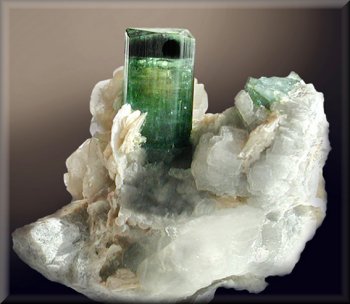 The Queen cm 3 x 2,5 x 2,5. the main Xl is cm 1,6 x 0,8. But some years ago a marvelous thing happened for me. Something that I had long hoped for but which, until then, had seemed an unreachable dream for all but the most skilled and fortunate of collectors. It was Easter 1996, when I and a friend of mine received a call from another friend who said 'Come quickly! Come quickly! I've just found something interesting!' And so we did: we rushed full of hope to find the Century's vein. Because of this, we celebrated Easter with a sandwich and a drink instead of the more celebratory lamb and delicacies. But if you collect with your heart, and love that life, there is no greater joy --- it could have been Christmas. Our group was joined by a good German friend, equally fond of Elba and its tourmalines. 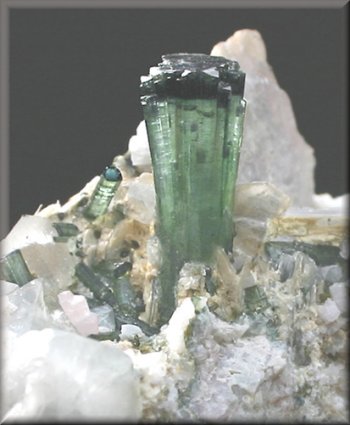 The King cm 10 x 6 x 6,the main crystal is cm 2,1 x 0,9,with many other elbaites blue cap around,and any morganites. The others were straining their backs, bathed in sweat, throwing granite boulders bigger than all three of them put together down the valley. They were working with their hammer-drills, jacks, and sledge hammers of improbable weights. In the meantime, I was the first to go ahead, creeping along the ground under the shrubs, getting torn up by the brambles and getting wet under the rain that started to fall. Not satisfied with these damages done to myself, and displeased by the absence of traces of good veins, I decided to concentrate on a little slide area between two thick bushes a few meters from my friends where I found elbaite traces that seemed to be from an old mine dump. I spent hours and hours on my knees amoung the ground and stones, hoeing with my humble garden tools, extracting pieces full of lepidolite but without a trace of other intact minerals. I was convinced that it was just an old mine dump, but rather than remaining without anything to do except watch the others who were working, I kept digging, hoping to find something good. I was repaid by my first elbaite specimen: a tourmaline about 1 x 0.5 cm, multicolored, very gemmy, with a body of an unusual 'Brazilian' green color and a black-blue band near the termination. It was attached to the side of an exceptionally big (5 x 5 cm) fan- shaped leaf of lepidolite. It was the first intact piece I found, and it made me happy enough and gave me the hope necessary to keep on digging. 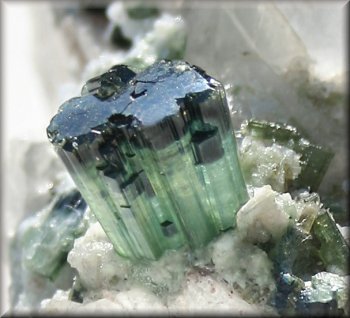 The Knight cm 8 x 8 x 7. th emain Xl stands among many similar elbaites and in fron of a big gemmy quartz. the size of Xl is cm 1,5 x 1,5. The next day the others went back to work on their hard granite and me to hoeing in the wet ground under a sun risen to heat the lukewarm breezy Elban spring air. I remember with vivid emotion the moment in which I realized that I was not hoeing in a mine dump, but rather something intact. I was making more room for myself, throwing behind me the loose dirt, when I saw something incredible --- something that at first glance seemed could not be true. But it was the right shape…there was no doubt… I took that 'stone', a little rock about 4 x 3 x 4 cm, to look at it more closely. And then I must have let out a cry in amazement. It was an elbaite of good size, 1.6 x 0.8 cm, totally gem, multicolored, elegantly perched on a matrix of quartz and albite, and partly hugged by romantic lepidolite rosettes. The color was once again a bright bluish green, with a black-blue band next to the crystal's termination, which was perfected and naturally faceted like a cut gemstone. The specimen was perfect just as I found it, without any need for trimming. The fact that it was still dirty from the ground made it seem all the more incredible in my eyes. The name 'The Queen' immediately came to mind. Meanwhile the others left their heavy granite cubes and rushed to me, a little worried but above all a little curious about my choked scream. When they saw what I found, they stood without words. They, too, became convinced that I was working in an intact vein rather than a mine dump. That beng the case, they helped me to dig deep to find the source of my treasure, which I later called 'The Easter Vein.' Those days are still impressed in my mind like a picture of splendid colors: my first important discovery: my first vein. I have gone back many times to dig in that place, with my boyfriend, Luca Gervino, discovering time after time that the vein was a real mystery: a part was worked out (who knows: maybe by our Mister Celleri in old times), a part was virgin but decomposed in place, which is where I found the most beautiful pieces (that I later named the Queen, King and Knight) hidden in the ground next to the old vein. That rich and unusual vein of pegmatite made its way through a very hard serpentine, alternating between well evolved zones, consisting of gemmy orthoclases and immense lepidolite leaves, and almost aplitic zones, which, however, contained good specimens of quartz with albite inclusions and “Moor’s head” elbaites,although not gemmy. 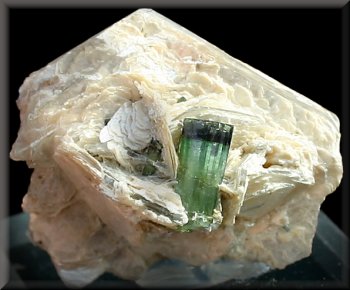 The rose has a "rose" shape ,created by many silverish lepidolite leafs. the main Xl is cm 1 x 0,6. the total size is cm 3 x 2,5 x 2.. The vein's size changed rapidly from a width of about 10 centimeters to a little more than half a meter. The grain was exceptionally big, and hidden among the pinkish lepidolite, the elbaites changed from a gemmy Brazilian green with black-blue band (like the King, Queen and Knight) to a similar gemmy green but with an electric BLUE termination. These small specimens are the very rare, and the biggest one (the BLUE LADY) is a wonderful crystal about 1 x 0.5 cm, standing in the middle of a pocket completely populated by 3 x 3 cm lepidolite leaves. I've nicknamed this last variety of tourmaline 'BLUE CAP.'sions and 'Moor's head' elbaites, although not gemmy. In other zones of the vein the concentration of rare elements was probably even higher, high even to give life to that rarest of varieties, indicolite, well crystallized but small. These tourmalines were often joined with well formed orthoclases crystals, colorless or white and partly transparent. The mineral partnership of the Easter Vein is very beautiful in my modest opinion, and (I've checked) very unusual for the locality. The pegmatites of Elba Island usually contain tourmalines that are green or pink, often multicolored, or with an 'olive-green' color tending toward brown. 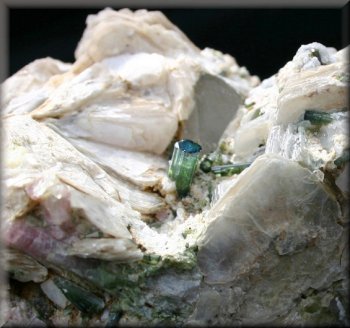 la DAMA BLU(the BLUE LADY)is the biggest BLUE CAP i founf in the vein:it's cm 1 x 0,5,with an electric blue termination. The color of elbaites from my vein is brightened by a characteristic shared by most of its tourmalines: the core of the body is gemmy and BLUE, covered by a superficial coating of dark but very tiny green. The resulting color is a bright green really far from the typical Elba 'yellowish-green.' The Easter Vein remains, however, the most beautiful mystery of my searcher life, as well as my first important find. Later, I went back many times, and again I will be back, on my adorable island, searching for my charming tourmalines. I believe I'll do that for the rest of my days, till when, who knows, the fairies willl want to make me one more precious gift. 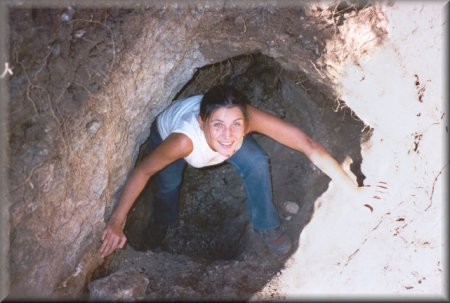 Photo took at the ending of my work in the pocket of the Vein. 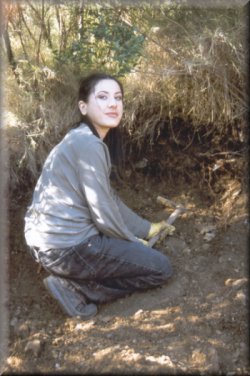 |